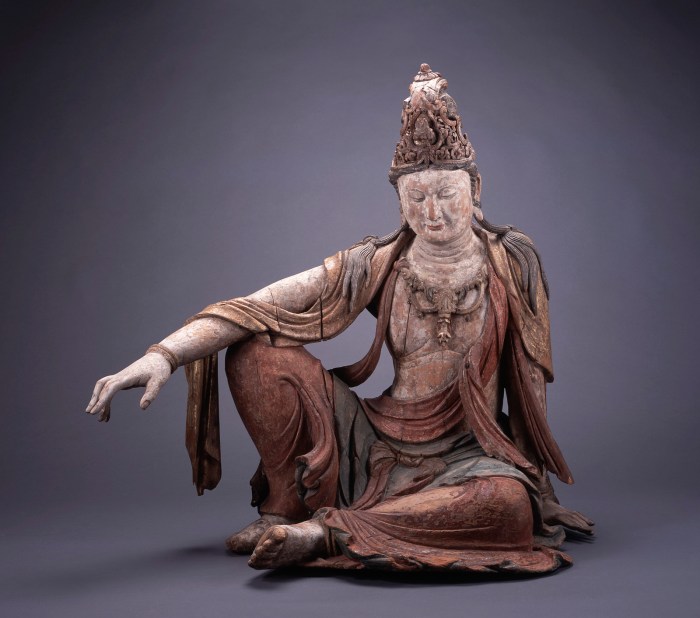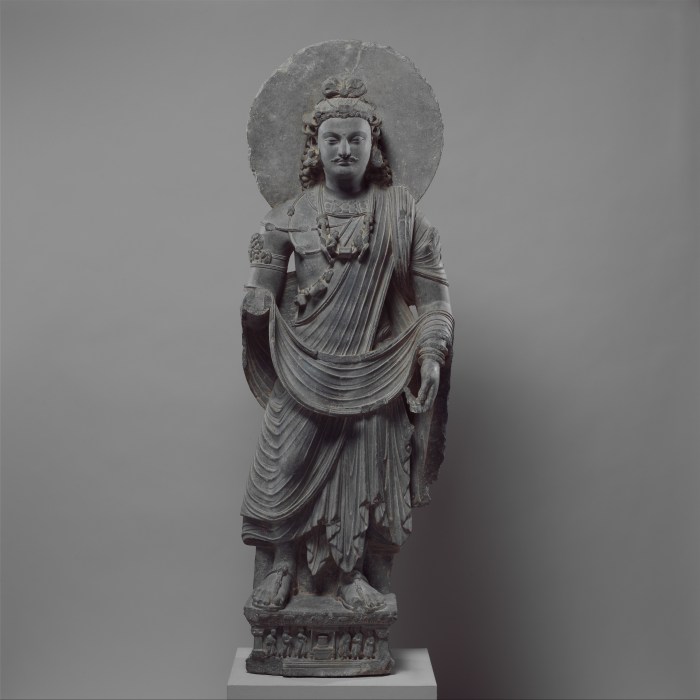The sculpture of which figure represents a bodhisattva is a captivating subject that delves into the rich history, symbolism, and cultural influences surrounding these sacred figures in ancient Asian art. Bodhisattva sculptures, embodying the ideals of compassion, wisdom, and enlightenment, have played a significant role in Buddhist practices and rituals, inspiring devotees and captivating art enthusiasts alike.
Throughout history, bodhisattva sculptures have been crafted in diverse styles and forms, reflecting the artistic traditions and beliefs of different regions. From the intricate carvings of ancient India to the serene stone sculptures of China and the vibrant bronze figures of Japan, each bodhisattva sculpture carries a unique narrative, revealing the multifaceted nature of these enlightened beings.
Bodhisattva Sculptures in Ancient Asia

Bodhisattva sculptures played a significant role in ancient Asian cultures, embodying the ideals of compassion, wisdom, and enlightenment. These sculptures were not only objects of veneration but also served as didactic tools, representing the path to enlightenment and the qualities of a bodhisattva.
Symbolism and Iconography
- Lotus throne:Symbolizes purity and detachment from worldly desires.
- Ushnisha:A cranial protuberance representing wisdom and enlightenment.
- Mudras:Hand gestures conveying specific teachings or aspects of the bodhisattva’s nature.
- Bodhi tree:The tree under which the Buddha attained enlightenment, often depicted with bodhisattvas.
Styles and Forms of Bodhisattva Sculptures
Bodhisattva sculptures exhibited a wide range of styles and forms across Asia, reflecting regional artistic traditions and cultural influences.
Artistic Techniques and Materials
- Stone carving:Granite, marble, and sandstone were commonly used in India and Southeast Asia.
- Bronze casting:Developed in China and Japan, allowing for intricate details and large-scale sculptures.
- Wood carving:Found in Japan, Korea, and Southeast Asia, creating delicate and expressive sculptures.
Notable Examples
- Bamiyan Buddhas, Afghanistan:Monumental stone carvings from the 6th century.
- Bodhisattva Avalokiteshvara, China:A 10th-century bronze sculpture known for its serene expression and flowing robes.
- Kannon, Japan:Wooden sculptures from the Heian period, depicting bodhisattvas with compassionate and graceful postures.
Bodhisattva Sculptures in Buddhism

Bodhisattva sculptures played a central role in Buddhist practices and rituals, serving as objects of devotion and inspiration.
Role in Practices and Rituals
- Meditation:Sculptures were used as focal points for meditation, helping practitioners connect with the qualities of bodhisattvas.
- Offerings:Offerings of flowers, incense, and food were made to sculptures as a way of expressing gratitude and seeking blessings.
- Pilgrimage:Temples and sites containing renowned bodhisattva sculptures became popular pilgrimage destinations.
Symbolism and Meanings of Hand Gestures, The sculpture of which figure represents a bodhisattva
- Varada mudra:Gesture of granting wishes and protection.
- Abhaya mudra:Gesture of fearlessness and reassurance.
- Dharmachakra mudra:Gesture representing the teaching of the Buddha’s dharma.
Cultural Influences on Bodhisattva Sculptures
The development of bodhisattva sculptures was influenced by various cultural factors, resulting in unique representations across different regions.
Regional Traditions and Beliefs
- India:Sculptures often depicted bodhisattvas with elongated bodies and elaborate ornaments, reflecting Hindu artistic traditions.
- China:Bodhisattvas were portrayed with more human-like features and often adorned with flowing robes, influenced by Confucian and Taoist aesthetics.
- Japan:Sculptures emphasized elegance and serenity, reflecting the influence of Shinto beliefs and the Japanese love of nature.
Unique Cultural Heritage
- Gandhara, Pakistan:Sculptures blended Greek and Indian elements, creating a distinct style known as Gandharan art.
- Bayon Temple, Cambodia:Bodhisattva faces were carved into the temple walls, reflecting the Khmer artistic tradition.
- Borobudur Temple, Indonesia:Reliefs depict bodhisattvas in various postures and gestures, showcasing the rich Buddhist heritage of Southeast Asia.
Bodhisattva Sculptures in Modern Art: The Sculpture Of Which Figure Represents A Bodhisattva
Bodhisattva sculptures continue to influence contemporary art and design, inspiring artists to explore themes of compassion, spirituality, and the human condition.
Influence on Contemporary Art
- Reinterpretation of Imagery:Artists have reimagined bodhisattva forms and symbols, creating new interpretations that reflect modern perspectives.
- Adaptation in Installations:Bodhisattva sculptures are incorporated into large-scale installations, exploring themes of enlightenment and the interconnectedness of all beings.
- Use of New Materials:Contemporary artists use innovative materials, such as recycled plastics and mixed media, to create bodhisattva sculptures that challenge traditional forms.
Notable Examples
- Ai Weiwei, “Bodhisattva in Shanghai”:A large-scale installation consisting of over 1,000 miniature bodhisattva sculptures.
- Yayoi Kusama, “Infinity Mirror Rooms”:Immersive installations featuring mirrored rooms with bodhisattva-like figures, creating a sense of infinite space and self-reflection.
- Anish Kapoor, “Cloud Gate”:A bean-shaped sculpture in Chicago, reflecting the city skyline and evoking the shape of a bodhisattva’s halo.
FAQ Resource
What is the significance of bodhisattva hand gestures and postures?
Bodhisattva hand gestures and postures, known as mudras, convey specific symbolic meanings. For example, the Abhaya mudra represents fearlessness, while the Varada mudra signifies generosity.
How have cultural factors influenced the development of bodhisattva sculptures?
Cultural factors such as regional traditions, beliefs, and artistic styles have shaped the representation of bodhisattvas in different cultures. For instance, Chinese bodhisattva sculptures often exhibit serene and contemplative expressions, while Japanese bodhisattvas may be depicted with more dynamic and expressive postures.
What is the role of bodhisattva sculptures in contemporary art?
Bodhisattva sculptures continue to influence contemporary art, inspiring artists to reinterpret and adapt bodhisattva imagery in their works. Modern artists explore the symbolism and aesthetics of bodhisattvas to convey themes of spirituality, compassion, and enlightenment.